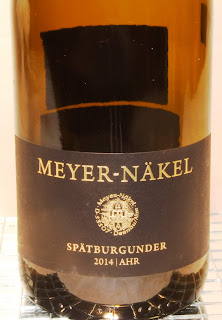“Those who cannot change their minds cannot change anything.” ….. George Bernard Shaw
The bottle is in the common
shape of that used for Pinot Noir. But what’s
inside the bottle is anything but common. Spatburgunder is what is known as
Pinot Noir in Germany, that country so well known for its white wines,
particularly Riesling. It’s too cold in
Germany to grow red wine grapes, or so a common mis-assumption goes which may explain
why non-German people don’t shop for it.
O.K., that’s a
generalization. But it’s pretty much a
fact too. Here’s another: Germans
reportedly enjoy the highest per-capita consumption of Sparkling Wine. And Germany is the world’s third largest
producer of Sparkling Wine after France and Italy. So yes, that means Germany produces more
Sparkling Wine (where it is known as Sekt) than even Spain produces its famous Cava
and Germany is three places ahead of the U.S. in Sparkling Wine production. But then, grapes used in Germany for premium
Sparkling Wine are mostly Riesling, Pinot Blanc (Weissburgunder), Pinot Gris (Grauburgunder)
and (surprise) Pinot Noir! And these grapes
do well in carefully selected sites with attention to exposure and taking full
advantage of any element of moderation.
Baden (in SW Germany near the border
with France) is an area well known for producing Spatburgunder. It is the
largest of Germany’s 13 wine growing areas (though only a small amount is
dedicated to viniculture) and is comprised of two unconnected segments along
the east side of the Rhine and three small subareas along Lake Constance. It
follows Rheinhessen and Pfalz in vineyard acreage. Moderation of temperatures is provided by the
river, lakes and steep slopes that take full advantage of the sun’s warming
influence.
Ahr, on the other hand (and
the source of this bottle), is one of the most northern regions and among the
smallest with just over 1,300 acres planted. In the past, Pinot Noir from this area was often
somewhat sweet and made from late-picked grapes. That changed in Germany’s red wine renaissance
of 1995-2000. Today, expect fully
fermented, dry, oak-aged wins of good complexity and reflecting a sense of place. Growers in Ahr take full advantage
of the areas’ micro-climates. Slopes on
either side of the Ahr river can reach 980 feet with the best slopes facing
south-east on soil of slate, basalt and greywacke clay. Sunlight is captured by these steep slopes,
reflected by the river and warmth retained by the black soil. At between 50-51 degrees latitude, viniculture
here requires such attention to detail and (to my palate) produces wine sharing
the affinity of the varietal but with a unique personality.
Opened and poured, the wine’s nose
was dusty plum and black fruit with some “funk”. Taste was soft, mostly black cherry with gentled
notes of black pepper. Light ruby in the glass, indicative of cool
climate. Light tannins – no surprise –
it’s Pinot Noir. In a way, it reminded me of a cru-Beaujolais but I’m
always looking for comparisons so that could just be me. Allowing the wine more air opened its fruit. Still black cherry but now lightened with
tart cranberry. Floral notes – lavender –
mixed with spice. I played between tasting
and sniffing, red fruit beginning to develop on the palate. The
wine was elegant. Finessed. A fine marriage of fruit to savory in a medium
finish wine.
If you, like so many of us,
look past Germany when considering a Pinot Noir, perhaps it’s time to change
your mind.
Prost!
…………………….. Jim
Follow and “like” Wine Mizer
on Facebook for mini-reviews, suggested food pairings, industry news and more.
Winemizer,net does not accept any
advertisements, nor is it affiliated with any winery, vineyard, importer or
distributor. You may be assured that any
opinions are not economically biased (though they may not be appropriate to your
individual and unique palate).
ETCETERA
The temperate zones at 20-50 degrees
latitude, north or south of the equator, are considered suitable for viniculture. Ahr, at 50-51 degrees is a challenging region
and one that imparts what I appreciate as a unique character in the hands of a
talented winemaker.
Werner Nakel was chosen winemaker of
the year (2004) in the Gaulty-Millau. In 2008, “Decanter Magazine” awarded him the
International Trophy for Pinot Noir and stated, “It’s a fantastic achievement
for Germany to win this trophy. Imagine it – they have beaten Burgundy, New
Zealand and Oregon, all acknowledged Pinot regions of the world.” In 2011, “Fallstaff” (Austria’s leading wine
publication) chose him for their highest award.
92 points Wine Enthusiast
Weingut Mayer-Nakel
ALC: 13%
Imported By: Cellars International Inc. (San Marcos CA)
ARP: NOTE: Be advised this makes no sense. 2014 $22, 2015 $30, 2016 $14. And I saw a quote from a reputable dealer at $56.50
for the 2014, none of which include S&H.
I bought it locally at Binny’s for $32.99.
 |
| Paired this wine with brats and a red cabbage that I made along with a German potato salad. But you can pair this Pinot as you would normally. |


No comments:
Post a Comment